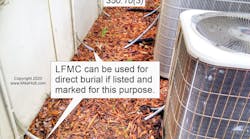Courtesy of www.MikeHolt.com.
All questions and answers are based on the 2023 NEC.
Q: What are the conditions liquid-tight flexible metal conduit (LFMC) can be used and installed?
A: Section 350.10 lists the conditions where LFMC can used and installed.
Listed LFMC is permitted, either exposed or concealed, at any of the following locations:
(1) If flexibility or protection from machine oils, liquids, vapors, or solids is required.
(2) In hazardous (classified) locations as permitted in Chapter 5.
(3)For direct burial if listed and marked for this purpose (see the Fhoto below).
(4) Conductors or cables rated at a temperature higher than the listed temperature rating of LFMC may be installed in LFMC, provided the conductors or cables are not operated at a temperature higher than the listed temperature rating of the LFMC per Sec. 110.14(C).
Q: What are the requirements for securing and supporting LFMC?
A: As stated in Sec. 350.30, LFMC must be securely fastened in place and supported in accordance with (A) and (B).
(A) Securely Fastened. LFMC must be securely fastened by a means approved by the authority having jurisdiction within 1 ft of termination and must be secured and supported at intervals not exceeding 4½ ft.
Where cable ties are used for securing LFMC they must be listed and identified for securement and support.
Exception No. 1: LFMC is not required to be securely fastened or supported where fished between access points through concealed spaces and supporting is impractical.
Exception No. 2: If flexibility is necessary after installation, unsecured lengths from the last point where the raceway is securely fastened are not permitted to exceed:
(1) 3 ft for trade sizes ½ through 1¼
(2) 4 ft for trade sizes 1½ through 2
(3) 5 ft for trade sizes 2½ and larger
Exception No. 4: Lengths not exceeding 6 ft from the last point where the raceway is securely fastened can be unsecured within an accessible ceiling for a luminaire(s) or other equipment. Listed fittings are considered a means of securement and support.
For these exceptions, listed LFMC fittings are permitted as a means of securement and support.
Author’s Comment: This last sentence following the four exceptions means that using LFMC fittings to secure and support only applies to installations made using one of the four exceptions. It should not be interpreted as permission to use these fittings to secure and support LFMC in all applications.
(B) Horizontal Runs. LFMC installed horizontally in bored or punched holes in wood or metal framing members, or notches in wooden members, is considered supported. Still, the raceway must be secured within 1 ft of termination.
These materials are provided by Mike Holt Enterprises in Leesburg, Fla. To view Code training materials offered by this company, visit www.mikeholt.com/code.






